Hickson 10 (GxG)

Image source: DSS II (red) - 20'×20'
|
| Name: |
Hickson 10, HCG10 |
| Type: |
GxG |
| Constellation: |
And |
| Coordinates: |
01h26m04.00s / +34°43'00.00" |
| Group Members: |
| NGC529 |
(UGC995) |
12m.2 |
2.4'×2.1' (160°) |
| NGC531 |
(UGC1012) |
14m.0 |
1.9'×0.6' (34°) |
| NGC536 |
(UGC1013, H3.171) |
12m.4 |
3.3'×1.2' (62°) |
| NGC542 |
|
14m.8 |
1.0'×0.2' (143°) |
|
| René Merting |
12.5" f/4.5, 144x, SQM-L 21.0
NGC 536 ist bei 144x hell, oval ost-west-elongiert, stellares Zentrum - nördlich in der Galaxie ist eine schwache stellare Aufhellung erkennbar, die sich bei 206x als schwacher Stern entpuppt - NGC 536 ist gut begrenzt und 2:1 elongiert
|
EASY
|
|
Hickson 34 (GxG)
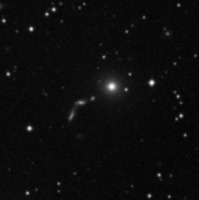
Image source: DSS II (blue) - 5'×5'
|
| Name: |
Hickson 34, HCG34, Arp327 |
| Type: |
GxG |
| Constellation: |
Ori |
| Coordinates: |
05h21m47.00s / +06°41'00.00" |
| Group Members: |
| NGC1875 |
|
13m.7 |
0.8'×0.7' |
| PGC17173 |
|
b18m.3 |
0.2'×0.2' |
| PGC17175 |
|
b17m.1 |
0.4'×0.2' |
| PGC17176 |
|
b17m.4 |
0.4'×0.2' |
|
|
|
|
Southeastern of the dominant NGC1875 are the three much more fainter members, which are arranged in a curved chain.
|
|
| Robert Zebahl |
8" f/6, 216x, Bortle 5+, SQM-L 20.9
Conditions in the target region: SQM-L 20.3
I've only tried the bright NGC1875 of course: Altitude of about 40°. Appeared round, almost evenly bright, difficult to hold with averted vision.
|
DIFFICULT
|
| René Merting |
12.5" f/4.5, 160x, SQM-L 21.3
bei 131x ist NGC 1875 indirekt als zarte Aufhellung sichtbar - bei 160x blitzt der Kern mitunter etwas heller hervor
|
MODERATE
|
|
Hickson 37 (GxG)

Image source: DSS II (blue) - 5'×5'
|
| Name: |
Hickson 37, HCG37 |
| Type: |
GxG |
| Constellation: |
Cnc |
| Coordinates: |
09h13m37.00s / +30°00'00.00" |
| Group Members: |
| MCG+5-22-16 |
(PGC26005, PGC26009) |
b16m.1 |
0.4'×0.3' |
| MCG+5-22-20 |
(PGC26004) |
b15m.8 |
0.4'×0.3' |
| NGC2783A |
(UGC4859, H3.295) |
12m.6 |
2.2'×1.5' (168°) |
| NGC2783B |
(UGC4856) |
14m.3 |
1.7'×0.2' (77°) |
|
| Robert Zebahl |
8" f/6, 200x, Bortle 4-, SQM-L 21.0
Conditions in the target region: NELM 5m4+
I only observed the two brightest members.
NGC2783A: Already visible at 80x with averted vision. Appeared roundish, quite well condensed, rather small.
NGC2783B: Appeared more as an almost stellar brightening, in few moments also elongated. Permanently seen with averted vision but pretty faint.
|
MODERATE
|
|
Hickson 44 (GxG)
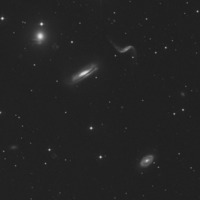
Image source: DSS II (blue) - 20'×20'
|
| Name: |
Hickson 44, HCG44 |
| Type: |
GxG |
| Constellation: |
Leo |
| Coordinates: |
10h17m59.00s / +21°47'18.00" |
| Group Members: |
| NGC3185 |
(UGC5554) |
12m.2 |
2.1'×1.4' (130°) |
| NGC3187 |
(UGC5556) |
12m.9 |
3.6'×1.7' (115°) |
| NGC3189 |
(NGC3190, UGC5559, H2.44) |
11m.2 |
4.5'×1.5' (118°) |
| NGC3193 |
(UGC5562, H2.45) |
10m.9 |
2.9'×2.8' (20°) |
|
|
|
|
Very bright Hickson group. Worthwhile!
|
|
| Robert Zebahl |
4.5" f/8, 75x, Bortle 7+
Only the two brightest members were visible. Both fairly well seen with averted vision. NGC3193 appeared roundish with brighter core, NGC3189 very elongated and nearly evenly bright, whereas only the brighter core was visible.
|
MODERATE
|
4.5" f/8, 75x, Bortle 4, NELM 6m.0
The two brightest members were apparent with averted vision: NGC3193 appeared roundish with brighter core, NGC3189 very elongated with also elongated, brighter core and fainter, diffuse outer region. NGC3185 perceptible with averted vision as fairly faint, roundish, evenly bright nebula.
|
EASY
|
8" f/6, 100x, Bortle 4
At 37x the two brightest members (NGC3189 & NGC3193) are clearly evident. NGC3179 is very elongated and shows at 100x an elongated, distinctly brighter core area. Dust lane wasn't seen, but galaxy appeared more sharply defined SW. NGC3193 is round with very bright, compact core. NGC3185 appears at 37x as a relatively small, faint brightening, at 100x evenly bright and slightly oval. Most difficult is NGC3187: Only at third attempt I was able to see it. At 171x very faint, very elongated, thin, evenly bright. Barely held with averted vision.
|
EASY
|
| René Merting |
B 18x70, SQM-L 21.3
an der Stelle, wo die Galaxie stehen soll, sehe ich zwei schwache Lichtpunkte, ein schwächerer im Osten (TYC 1426-260-1 / 10m6) und ein hellerer im Osten (TYC 1425-43-1 / 9m8), von der Galaxie leider keine Spur - kurioserweise kann ich aber NGC 3189 als indirekt schmalen, schwachen, nebligen Schimmer erkennen, die von den Eckdaten eigentlich schwieriger ist - vielleicht habe ich in dem westlichen Lichtpunkt ja doch die kompakte Galaxie NGC 3193 gesehen, sie scheint zumindest auf dem DSS-Ausschnitt heller zu wirken als der 9m8 helle Stern unmittelbar nördlich darüber
|
DIFFICULT
|
12.5" f/4.5, 144x, SQM-L 21.3
NGC 3185: bei 144x unscheinbar, aber gut direkt erkennbar und homogen hell - indirekt leicht heller und etwas diffus - bei 240x wirkt die Galaxie indirekt etwas fleckig
NGC 3187: bei 144x indirekt als ganz zarter Nebelschimmer erkennbar - kann auch länger gehalten werden
NGC 3189: bei 144x größer und heller als die nordöstlich stehende NGC 3193, leicht längliches Zentrum
NGC 3193: bei 144x südlich von einem Stern zu erkennen, kompakt mit hellem Zentrum
|
EASY
|
|
Hickson 53 (GxG)

Image source: DSS II (blue) - 10'×10'
|
| Name: |
Hickson 53, HCG53 |
| Type: |
GxG |
| Constellation: |
Leo |
| Coordinates: |
11h29m00.00s / +20°46'30.00" |
| Group Members: |
| NGC3697 |
(NGC3697A, UGC6479, PGC35347) |
b14m.1 |
2.4'×0.7' (93°) |
| NGC3697B |
(PGC35355) |
b15m.3 |
0.7'×0.5' (170°) |
| NGC3697C |
(PGC35360) |
b15m.3 |
0.5'×0.4' (120°) |
| PGC35381 |
|
b16m.8 |
0.5'×0.2' (90°) |
|
| Robert Zebahl |
8" f/6, 150x, Bortle 3, SQM-L 21.4
Conditions in the target region: SQM-L 21.0
NGC3697A: Brightest member of the group. Elongated, evenly bright & wide.
NGC3697B: Roundish, slightly condensed. Overall pretty faint. Located northwest near NGC3697C.
NGC3697C: Unfortunately not seen, although the northwestern NGC3697B was feasible.
|
MODERATE
|
|
Hickson 56 (GxG)
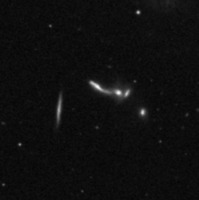
Image source: DSS II (blue) - 5'×5'
|
| Name: |
Hickson 56, HCG56 |
| Type: |
GxG |
| Constellation: |
UMa |
| Coordinates: |
11h32m40.00s / +52°56'40.00" |
| Group Members: |
| PGC35609 |
|
b16m.5 |
0.5'×0.3' (170°) |
| PGC35615 |
|
b17m.0 |
0.5'×0.3' (148°) |
| PGC35618 |
|
b15m.9 |
0.8'×0.6' (72°) |
| PGC35631 |
|
b16m.0 |
1.0'×0.2' (172°) |
| UGC6527 |
(PGC35620) |
14m.6 |
0.8'×0.4' (53°) |
|
| Robert Zebahl |
8" f/6, 200x, Bortle 3, NELM 6m.5, SQM-L 21.6
Difficult. Nearly permanently held with averted vision as very compact, slightly elongated brightening, which is UGC6527 and maybe the two western galaxies PGC35615 and PGC35618. At 265x I thought to have seen two separate brightenings, but not for sure.
|
DIFFICULT
|
| René Merting |
12.5" f/4.5, 206x, SQM-L 21.3
Nacht mit schlechtem Seeing, aber Zenitbeobachtung
UGC 6527: bei 160x sichtbar - bei 206x indirekt als eine von zwei Kondensationen im länglich wirkenden Nebelfleck um die beiden weiteren PGC 35615 und PGC 35618 erkennbar
PGC35609: trotz intensiver Bemühungen bis 206x nicht gesehen
PGC 35615 & PGC 35618: bei 206x als länglicher Nebel zusammen mit PGC 35618 und UGC 6527 erkennbar - eine Kondensation ist ebenfalls sichtbar, ggf. durch beide PGC´s zusammen bewirkt
PGC 35631 nö, nicht bei den Bedingungen
|
MODERATE
|
|
Hickson 57 (GxG)

Image source: DSS II (blue) - 8'×8'
|
| Name: |
Hickson 57, HCG57, Arp320, Copeland's Septet |
| Type: |
GxG |
| Constellation: |
Leo |
| Coordinates: |
11h37m51.00s / +21°59'00.00" |
| Group Members: |
| NGC3745 |
|
b16m.4 |
0.6'×0.4' (110°) |
| NGC3746 |
(UGC6597) |
b15m.3 |
1.1'×0.5' (125°) |
| NGC3748 |
|
14m.8 |
0.7'×0.4' (140°) |
| NGC3750 |
|
13m.9 |
0.8'×0.7' (160°) |
| NGC3751 |
|
14m.3 |
0.8'×0.5' (5°) |
| NGC3753 |
(UGC6602) |
13m.6 |
1.7'×0.5' (120°) |
| NGC3754 |
|
b15m.2 |
0.4'×0.3' (35°) |
| PGC36010 |
|
b17m.4 |
0.4'×0.3' (20°) |
|
| Robert Zebahl |
8" f/6, 200x, Bortle 4, SQM-L 21.2
Conditions in the target region: SQM-L 21.0
NGC3746: Roundish (?), faint. Brighter and larger than NGC3748.
NGC3748: Faint, roundish, pretty small.
NGC3750: Located southwest of NGC3753. Difficult to separate from brighter NGC3753. Just visible as very faint, roundish brightening. Held with averted vision.
NGC3751: Most southern member of the group. Unfortunately for some reason I didn't tried this one.
NGC3753: Slightly elongated, rather evenly bright, pretty faint. Brightest and largest member of the group.
NGC3754: Northeast close to NGC3753. At 220x & 220x absolutely nothing was seen.
|
MODERATE
|
16" f/4.5, 225x, Bortle 4, SQM-L 21.2
Conditions in the target region: SQM-L 21.0
NGC3745: Round, compact brightening. Anything but evident at 225x.
NGC3746: Evident, slightly oval, getting a bit brighter towards the middle. Still visible with direct vision.
NGC3748: Small, round brightening. Well seen with averted vision.
NGC3750: Roundish, condensed brightening. Almost visible with direct vision.
NGC3751: Most southern member of the group. Unfortunately for some reason I didn't tried this one.
NGC3753: Obviously oval/slightly elongated, getting brighter towards the middle. Still visible with direct vision.
NGC3754: Ziemlich schwache, rundliche Aufhellung dicht an NGC3753.
|
EASY
|
|
Hickson 58 (GxG)
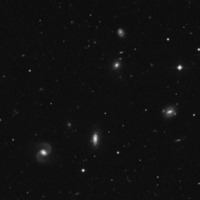
Image source: DSS II (blue) - 12'×12'
|
| Name: |
Hickson 58, HCG58 |
| Type: |
GxG |
| Constellation: |
Leo |
| Coordinates: |
11h42m10.00s / +10°19'00.00" |
| Group Members: |
| NGC3817 |
(UGC6657) |
13m.3 |
1.0'×0.9' (140°) |
| NGC3819 |
|
13m.8 |
0.8'×0.7' (140°) |
| NGC3820 |
|
14m.4 |
0.7'×0.4' (20°) |
| NGC3822 |
(NGC3848, H2.153, H3.35) |
12m.8 |
1.4'×0.8' (175°) |
| NGC3825 |
(NGC3852, UGC6668, H2.154, H3.36) |
13m.0 |
1.3'×1.0' (160°) |
|
| René Merting |
12.5" f/4.5, 144x, SQM-L 21.3
NGC 3817: bei 72x indirekt kompakt sichtbar, der zweithellste Nebel im Quintett um HCG 58 - bei 144x leicht helleres Zentrum
NGC 3819: bei 72x indirekt kompakt sichtbar, die dritthellste Galaxie im Quintett um HCG 58 - bei 144x indirekt etwas heller, aber immernoch schwach
NGC 3820: nicht darauf geachtet
NGC 3822: bei 72x indirekt der hellste Nebel in der Fünfergruppe um HCG 58, kompakt - bei 144x helles kompaktes Zentrum
NGC 3825: nicht darauf geachtet
|
EASY
|
|
Hickson 61 (GxG)
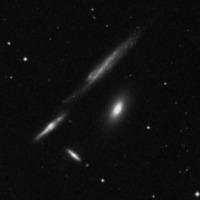
Image source: DSS II (blue) - 8'×8'
|
| Name: |
Hickson 61, HCG61, The Box |
| Type: |
GxG |
| Constellation: |
Com |
| Coordinates: |
12h12m22.00s / +29°11'09.00" |
| Group Members: |
| NGC4169 |
(UGC7202, H3.358) |
12m.3 |
1.8'×0.9' (150°) |
| NGC4173 |
(UGC7204, H2.372) |
12m.7 |
5.0'×0.7' (128°) |
| NGC4174 |
(UGC7206, H3.359) |
13m.6 |
0.8'×0.3' (50°) |
| NGC4175 |
(UGC7211, H3.360) |
13m.4 |
1.8'×0.4' (130°) |
|
| Robert Zebahl |
120mm f/5, 48x, Bortle 4, SQM-L 21.3
I only saw the brightest member NGC4169. At 48x still compact, at 85x roundish to slightly oval, condensed.
|
MODERATE
|
8" f/6, 100x, Bortle 3, NELM 6m.3, SQM-L 21.5
All four members were visible. NGC4169 is brightest member and apparent with direct vision. Appeared as oval nebula with brighter core. NGC4174 & NGC4175 appeared elongated, whereas NGC4174 is fairly compact. Both galaxies well seen with averted vision. NGC4173 held with averted vision, very thin & elongated, but quite faint and evenly bright. An awesome group of galaxies, especially when you see all members at once!
|
MODERATE
|
8" f/6, 150x, Bortle 4
NGC4169 most easy, which can be seen with direct vision as an oval nebula with much brighter core. Smallest and second brightest regarding to high surface brightness is NGC4174: relatively small, elongated, apparent with averted vision. More difficult is NGC4175: Permanently held with averted vision as elongated nebula. Largest, but very faint NGC4173 not seen.
|
MODERATE
|
| René Merting |
12.5" f/4.5, 111x, SQM-L 21.3
NGC 4169: bei 111x ist diese Galaxie die hellste der Vierergruppe
NGC 4173: bei 111x ist die Galaxie in voller Länge erkennbar - wenn man indirekt hinschaut, verschmilzt sie mit der kleineren südöstlich stehenden Spindel NGC 4175 zu einem noch längeren Strich
NGC 4174: bei 111x ist die Galaxie direkt klein und kompakt erkennbar
NGC 4175: bei 111x ist die Galaxie direkt elongiert auszumachen - indirekt betrachtet verschmilzt sie mit der größeren nordwestlich stehenden Spindel NGC 4173 zu einem langen Strich
|
EASY
|
|
Hickson 68 (GxG)

Image source: DSS II (blue) - 13'×13'
|
| Name: |
Hickson 68, HCG68 |
| Type: |
GxG |
| Constellation: |
CVn |
| Coordinates: |
13h53m40.00s / +40°19'00.00" |
| Group Members: |
| NGC5350 |
(UGC8810, H2.713) |
11m.3 |
3.2'×2.6' (40°) |
| NGC5353 |
(UGC8813, H2.714) |
11m.0 |
2.8'×1.9' (145°) |
| NGC5354 |
(UGC8814, H2.715) |
11m.4 |
2.2'×2.0' |
| NGC5355 |
(UGC8819, H3.699) |
13m.1 |
1.2'×0.7' (5°) |
| NGC5358 |
(UGC8826) |
13m.6 |
1.1'×0.3' (138°) |
|
|
|
|
Very bright Hickson Group. The brightest members should be well visible also with smaller aperture.
|
|
| Robert Zebahl |
8" f/6, 37x, Bortle 4, NELM 6m.0
At 37x the two brightest members NGC5353 and NGC5354 are evident with averted vision and clearly separated from each other. At 100x NGC5353 appeared slightly oval with bright, distinct core, whereas NGC5354 appeared more roundish and evenly bright. Also well visible is NGC5350, which is largest member of the group. Already visible at 37x with averted vision as relatively large, roundish, rather faint brightening. At 100x the center was somewhat brighter. The much more fainter NGC5355 was well seen at 150x with averted vision as slightly elongated brightening. The faintest member is NGC5358: At 150x I could barely see this galaxy with averted vision as very compact, diffuse brightening, which was probably only the bright core area.
|
EASY
|
|
Hickson 88 (GxG)
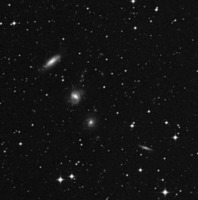
Image source: DSS II (red) - 12'×12'
|
| Name: |
Hickson 88, HCG88 |
| Type: |
GxG |
| Constellation: |
Aqr |
| Coordinates: |
20h52m24.00s / -05°44'59.00" |
| Group Members: |
| MCG-1-53-14 |
(PGC65612) |
b15m.0 |
1.1'×0.3' (70°) |
| NGC6975 |
(NGC6976) |
14m.0 |
0.8'×0.7' (5°) |
| NGC6977 |
|
13m.2 |
1.3'×0.9' |
| NGC6978 |
|
13m.3 |
1.5'×0.7' (125°) |
|
| Robert Zebahl |
8" f/6, 171x, Bortle 4, NELM 6m.0+, SQM-L 21.1
Conditions in the target region: SQM-L 20.6
Alt ca. 32°: Due to its low altitude this galaxy group can be a real challenge for 8 inch. Only the two brightest members were visible, which appeared similar bright. NGC6978 is the largest one and appeared elongated and almost evenly bright at 171x. However this galaxy wasn't evident at the first glance, but afterwards easily held with averted vision. NGC6977 is similarly difficult, somewhat fainter, roundish and evenly bright.
|
MODERATE
|
33" f/3.9, 194x, Bortle 4, NELM 6m.0+, SQM-L 21.1
Conditions in the target region: SQM-L 20.6
Alt ca. 32°: The two brightest members were obvious and visible with direct vision. NGC6978 was obviously elongated with a brighter core, NGC6977 was smaller, roundish to slightly oval with somewhat brighter core. Between these two galaxies a star was apparent. NGC6975 was fainter and only visible with averted vision as roundish nebula with also somewhat brighter core. All three galaxies are arranged in a line with almost same distances. A nice view! The faintest member (PGC65612) wasn't visible due to problems with dew on the secondary mirror. With large aperture a very nice Hickson Group.
|
EASY
|
| René Merting |
12.5" f/4.5, 206x, SQM-L 20.9
NGC 6978 ist bei 206x am einfachsten, sie fällt als leichter Schimmer auf, leicht länglich und homogen hell
NGC 6977 zeigt sich bei 206x etwa halb so hell und halb so groß wie NGC 6978 nördlich
NGC 6976 ist indirekt sichtbar und kann gehalten werden, schwach
PGC 65612 lässt sich gut lokalisieren durch die 4 Sterne im Norden, die einen Bogen bilden, bei 206x ist ab und an ein ganz zarter, länglicher Schimmer als Aufblitzen zu erkennen, leicht von Osten nach Westen ausgedehnt und sehr schwierig zu halten, die Sichtung ist nicht beliebig wiederholbar
|
MODERATE
|
|
Hickson 92 (GxG)

Image source: DSS II (blue) - 7'×7'
|
| Name: |
Hickson 92, HCG92, Arp319, Stephan's Quintet |
| Type: |
GxG |
| Constellation: |
Peg |
| Coordinates: |
22h35m57.50s / +33°57'36.00" |
| Group Members: |
| NGC7317 |
|
13m.6 |
0.7'×0.6' (150°) |
| NGC7318A |
(UGC12099) |
13m.4 |
0.9'×0.9' (90°) |
| NGC7318B |
(UGC12100) |
13m.2 |
1.9'×1.2' (120°) |
| NGC7319 |
(UGC12102) |
13m.5 |
1.7'×1.3' (148°) |
| NGC7320 |
(UGC12101) |
12m.6 |
2.2'×1.1' (132°) |
|
| Robert Zebahl |
4.5" f/8, 60x, Bortle 3, NELM 6m.3+, SQM-L 21.3
A rather difficult group for 4.5 inch. Transparent sky is very important. At 60x I saw a brightening, that includes NGC7318A/B and NGC7320. Separating them was difficult. Only at 100x I could separate both for sure and they appeared as oval nebulas.
|
MODERATE
|
152mm f/5.9, 129x, Bortle 4, SQM-L 21.0
Only the two brightest members were visible. NGC 7320 appeared oval, faint, almost equally bright, NGC 7318A/B also oval, moderately condensed.
|
MODERATE
|
152mm f/8, 171x, Bortle 4, SQM-L 21.2
The two brightest members, NGC 7320 and NGC 7318A/B, were visible quite well with averted vision as faint, oval nebulae. While NGC 7320 appeared rather uniform, NGC 7318A/B showed a slight increase in brightness towards the center. NCG 7317 was only visible as a very compact brightening close to the faint field star and was by no means easy to see. NGC 7319 was not visible.
|
MODERATE
|
8" f/6, 150x, Bortle 4, SQM-L 21.0
Wonderful, but more fainter group near NGC7331. NGC7318A/B appeared at 80x as oval, evenly bright nebula with averted vision and is brightest member. At 214x I could separate the cores of both galaxies with averted vision. NGC7320 was also fairly easily seen at 80x with averted vision, oval, relatively faint. NGC7317 is located nearby a 13.4m star and appeared at 150x as a very compact brightening. NGC7319 is the faintest member in this group and was visible at 150x as an extremely faint glow.
|
MODERATE
|
| René Merting |
12.5" f/4.5, 206x, SQM-L 21.3
NGC 7317: bei 111x als stellare Aufhellung eindeutig sichtbar
NGC 7318 & 7318A: bei 72x beide zusammen als ein Nebelfleck erkennbar - bei 206x dann ist die Trennung sichtbar und die Kerne beider Galaxien blitzen stellar auf
NGC 7319: bei 72x als nebliges Flecken erkennbar - bei 111x die am zweitbesten sichtbare Galaxie, leicht länglich
NGC 7320: bei 72x als schwacher Schimmer auszumachen - bei 111x ist sie die leichteste Galaxie dieser Gruppe mit einer leichten Kondensation südöstlich
|
EASY
|
12.5" f/4.5, 206x, SQM-L 21.3
NGC 7317: bei 111x als stellare Aufhellung eindeutig sichtbar
NGC 7318 & 7318A: bei 72x beide zusammen als ein Nebelfleck erkennbar - bei 206x dann ist die Trennung sichtbar und die Kerne beider Galaxien blitzen stellar auf
NGC 7319: bei 72x als nebliges Flecken erkennbar - bei 111x die am zweitbesten sichtbare Galaxie, leicht länglich
NGC 7320: bei 72x als schwacher Schimmer auszumachen - bei 111x ist sie die leichteste Galaxie dieser Gruppe mit einer leichten Kondensation südöstlich
|
EASY
|
|
Hickson 93 (GxG)

Image source: DSS II (blue) - 12'×12'
|
| Name: |
Hickson 93, HCG93 |
| Type: |
GxG |
| Constellation: |
Peg |
| Coordinates: |
23h15m22.00s / +18°59'30.00" |
| Group Members: |
| NGC7547 |
(UGC12453) |
13m.7 |
1.1'×0.5' (95°) |
| NGC7549 |
(UGC12457) |
13m.0 |
2.8'×0.7' (8°) |
| NGC7550 |
(UGC12456, H3.181) |
12m.2 |
1.4'×1.2' (150°) |
| NGC7553 |
|
14m.4 |
0.7'×0.6' (165°) |
| NGC7558 |
|
14m.9 |
0.4'×0.4' (65°) |
|
| Robert Zebahl |
8" f/6, 96x, Bortle 4-, NELM 5m.7+, SQM-L 20.8
Conditions in the target region: SQM-L 20.6
Largest and brightest member is NGC7550, which was barely visible with direct vision at 96x. This galaxy appeared roundish with slightly brighter center, otherwise rather evenly bright. At 133x the core appeared very compact. Second brightest member is NGC7549, which appeared at 96x roundish, at 133x partly slightly oval. Overall quite faint, but well perceptible with averted vision. The slightly fainter NGC7547 was seen at 96x only as rather compact brightening, at 133x evenly bright. Probably I only saw the brighter core area. The two faintest members 7553 & 7558 I didn't tried until now.
|
MODERATE
|
|
Hickson 94 (GxG)

Image source: DSS II (blue) - 6'×6'
|
| Name: |
Hickson 94, HCG94 |
| Type: |
GxG |
| Constellation: |
Peg |
| Coordinates: |
23h17m16.00s / +18°43'00.00" |
| Group Members: |
| NGC7578A |
(UGC12477, H3.182.1) |
13m.9 |
0.7'×0.6' (90°) |
| NGC7578B |
(UGC12478, H3.182.2) |
14m.0 |
1.7'×1.2' (25°) |
| NGC7578C |
(PGC70936) |
b16m.5 |
0.3'×0.2' |
| PGC70937 |
|
b18m.1 |
0.6'×0.2' |
| PGC70939 |
|
b18m.2 |
0.3'×0.2' |
| PGC70941 |
|
b18m.6 |
0.2'×0.2' |
| PGC70943 |
|
b16m.4 |
0.8'×0.3' |
|
| Robert Zebahl |
8" f/6, 171x, Bortle 4-, NELM 5m.7+, SQM-L 20.8
Conditions in the target region: SQM-L 20.6
The level of difficulty is only related to the two brightest group members (NGC7578A/B). The other members might be too faint for 8 inch aperture. At 66x I could easily see with averted vision around NGC7578A/B a faint, evenly bright glow, which appeared slightly oval at higher magnification. At 171x I could fairly well see within this glow the two rather compact cores of NGC7578 A/B, which were clearly separated from each other. The core of NGC7578 B (northeastern of NGC7578 A) appeared a bit brighter and larger. I didn't looked for the other members of course, but the third brightest one (PGC70943) might be worth trying ;-)
|
MODERATE
|
|
Hickson 95 (GxG)

Image source: DSS II (blue) - 5'×5'
|
| Name: |
Hickson 95, HCG95, Arp150 |
| Type: |
GxG |
| Constellation: |
Peg |
| Coordinates: |
23h19m30.00s / +09°30'00.00" |
| Group Members: |
| MCG+1-59-46 |
(PGC71074) |
b16m.1 |
0.8'×0.2' |
| MCG+1-59-48 |
(PGC71080) |
15m.2 |
0.8'×0.3' |
| NGC7609 |
|
14m.2 |
1.3'×1.1' (60°) |
| PGC71077 |
|
16m.1 |
0.7'×0.4' |
|
| Robert Zebahl |
8" f/6, 171x, Bortle 4-
This observation was a while back and I could only saw NGC7609 as very faint, roundish brightening, but at the limit of perception with averted vision. But don't expect too much from this Hickson/Arp group with 8 inch aperture.
|
DIFFICULT
|
|














